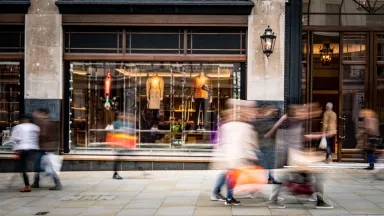US Stores Risk Customer Backlash Over Safety Issues Ahead of Holiday Rush
Our social feeds have been filled with images of smash and grab-style looting at shopping malls and violent exchanges in stores. Headlines in the news have told us leaders at retail giants are increasing prices, in part, due to this rise in retail crime.
This has a material impact on the bottom line for retailers – not just from shrinkage, which has ballooned to $112 billion annually – but also, importantly, from decreased foot traffic from fearful shoppers and concerned employees leaving their jobs.
With holiday shopping – the most critical season for retailers – around the corner, we surveyed more than 2,000 Americans in partnership with the Harris Poll to better understand how this is all impacting the consumer and uncover how retailers can respond. Here is what we learned:
The majority of Americans (81%) are concerned about their personal safety when shopping. It's not just major cities like Atlanta, Chicago and San Francisco that are contending with this – the data shows that it is universal and runs across every region, gender, income level, and generation.

This concern is growing with holiday shopping – traditionally the season with the highest foot traffic in stores – on the horizon. Two-thirds of Americans report that they are more concerned about their personal safety while holiday shopping this year than they were last year.
These fears aren’t unfounded. Data from the Council on Criminal Justice show that violent crimes during the first half of 2023 are higher than pre-pandemic levels. Data from the National Retail Federation also underscores how this is playing out in retail stores: more than half of retailers report they’ve seen an increase of guest-on-associate violence (e.g., customer dissatisfaction), violence involving a weapon and violence during a shoplifting event in stores. Further, 66% of retail workers reported experiencing a security incident in the past year, according to a 2023 Verkada survey of frontline workers.
Americans are most worried about safety at shopping malls. But there's a promising outlook for small, family-owned retailers and local shops still recovering post-pandemic — such establishments, along with grocery stores, evoke significantly less concern. This contrast highlights a potential shift in the shopping habits of American consumers, where community-based retail may offer charm and a haven of safety in a rapidly changing retail environment.

Americans aren’t confident that retail staff can handle these alarming situations when they do arise. 7 in 10 (68%) don’t think that frontline retail employees are equipped to respond to violent incidents, theft and crime.
The bottom line is that unless stronger safety and security measures are put in place, brick-and-mortar retail is at risk this holiday season. The majority of consumers (86%) are making a change in their holiday shopping behavior amid this rise in concern for their safety. The top three things they indicated that they will do are: shopping online for home delivery, being more selective about where they shop, and avoiding shopping during peak days/times.
To ease these consumer concerns during the holiday shopping season, it will be critical for retailers not only to invest in security measures – but also to take visible actions that assure customers that safety is a priority. Three ways retailers can take action today include:
Implementing deterrents. While security guards remain an important deterrent, the current labor shortage has made security personnel increasingly scarce. Advanced systems integrating remote video monitoring, automated alarms, and speakers with talk-down capabilities can make it easier for retailers of all sizes and scales to deter would-be thieves from carrying out crimes.
Providing staff with resources and training. It is critical for frontline retail employees to have the training and resources to respond to these events. Tools like panic buttons that are programmed to take action – whether it is alerting law enforcement or triggering a lock-down – help ensure that employees are able to take action swiftly. Importantly, training on how to respond in different scenarios and use these tools should be an ongoing commitment and not a one-time event.
Increasing visibility of anti-theft measures. It’s not just new technology like RFID tags or electronic article surveillance (EAS) tags that can help deter theft – locked display cases, visible security cameras and altered store layouts can also make a difference.
Holiday shopping is a ritual steeped in joy and the creation of lifelong memories, but this treasured experience is under threat if retailers don’t take action.





